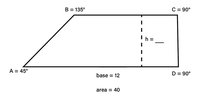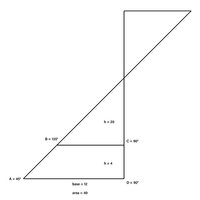morkfromork
New member
- Joined
- Dec 17, 2020
- Messages
- 4
Hi all
This is a very tricky problem that has bothered me for a long time, and now I thought my brain might not be so brilliant as yours.
I am trying to construct an equation to find the height of a trapezoid of which I know the area and the angles but only one base.
So for example, if I have a trapezoid that has a base of 12, angles 45, 135, 90 and 90, and an area of 40, how would I find out its height?

Of course this can be done by some guessing as these are all easy rounded numbers, but I am curious about what the equation would be.
I know it must be possible, but I cannot find any clue online on how to do it.
I hope someone can help me crack this one!
This is a very tricky problem that has bothered me for a long time, and now I thought my brain might not be so brilliant as yours.
I am trying to construct an equation to find the height of a trapezoid of which I know the area and the angles but only one base.
So for example, if I have a trapezoid that has a base of 12, angles 45, 135, 90 and 90, and an area of 40, how would I find out its height?

Of course this can be done by some guessing as these are all easy rounded numbers, but I am curious about what the equation would be.
I know it must be possible, but I cannot find any clue online on how to do it.
I hope someone can help me crack this one!

